So, last weekend our local Amnesty International group had events on both Bhopal and Tiananmen Square. I know some are going to say they’re both too far in the past. Surely everything is settled now, everything is different now? Yet much isn’t.
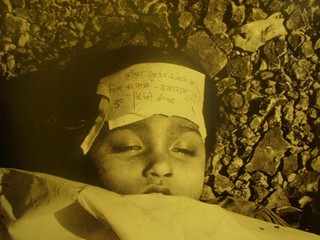
photo from the International Campaign for Justice in Bhopal
I unfortunately missed the two films on Bhopal shown that Friday night, Hush Baby, and Secrets and Lies. I remembered the film we co-sponsored a few years back on Bhopal, when AI was involved in the issue as part of our Corporate Accountability Network. It was the children who got the worst of the initial toxic leak in 1984, as whatever the chemical mixture is (and Dow, which has bought out Union Carbide, still isn’t telling), it stayed very close to the ground as families were trying to flee the horror in the middle of the night.
Sadly, it is still the children getting the worst of it, born with birth defects as Union Carbide is not taking responsibility for cleaning up the still toxic brew, which is seeping into the groundwater.
According to the International Campaign for Justice in Bhopal:
The monsoons of two decades have washed the chemicals deep into the soil and into the underground acquifers which feed wells and boreholes. The drinking wells and tap of communities living within a considerable radius of the plant have been contaminated with chemicals that are implicated in cancers and birth-defects. People have no other water supply and have been forced to drink and wash in Union Carbide’s diluted poisons. 20,000 people are affected.
I did make the panel discussion on Bhopal last Saturday, which included two members of the Bhopal Survivors Tour and Dr. Sheela Sathyanarayana from the University of Washington.
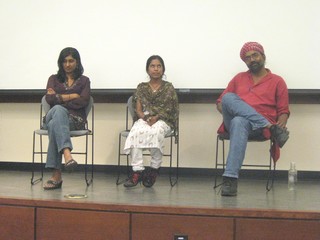
Satinnath Sarangi, who founded the Sambhavna Clinic for Bhopal Survivors, talked about the difficulty of getting information or even being able to treat survivors with effective methods starting right after the disaster, when Union Carbide put the pressure on the Indian government to stop. Evidently their lawyers had warned that to admit the treatment was working would be admitting liablility. No accounting for what gases leaked has ever been given, due to claims of “trade secrets,” even though that is information seriously needed to help survivors. It has been a struggle to even get clean water shipped in for the impoverished community near the still leaking site. Meanwhile, Dow claims the case can’t be heard in the Indian courts because they’re an American country, yet the case keeps being denied in the U.S. because it happened on foreign soil.
Safreen “Rafat” Khan, a 16 year old second-generation victim talked about the effects on her family, where her mother, father, and older brother are all sick from the poisons.
Then Dr. Sathyanarayana brought it home with the “toxic trespass” that is happening in all of us. She brought up the study from the Toxic-Free Legacy Coalition published last year which got a lot of press, including this article in the Seattle Times. All the participants, and certainly all of us as well, have multiple toxic chemicals in us. The recent issue of BPA in baby bottles and the plastic water bottles many of us used is one example. Cosmetics are another. These chemicals are deemed “innocent until proven guilty” instead of being tested for safety thoroughly first.
It seems overwhelming to deal with. Should we be alarmed? When she starts citing the higher incidence of cancers like breast and prostate cancers at small doses, and you start realizing how many people you know with cancer. . .
Back to Bhopal, by far one of the worst, if not the worse example of “toxic trespass.” One of the things that the survivors are asking is for people to take action by contacting their Congressional Representative to sign on to a “Dear Colleague” letter “which is addressed to the CEO and Board of The Dow Chemical Company asking Dow to present Union Carbide in Indian Criminal court and clean up the spreading toxic mess in Bhopal.”
Then on last Sunday, at Hing Hay Park (and again Thursday at UW), we commemorated the 20th Anniversary of the Tiananmen Square crackdown (as we’re supposed to call it as AI members, although, personally, I think “massacre” is more accurate).
The student protests on Tiananmen Square of April and May 1989 were quite amazing and courageous even to those of us watching on tv miles away. Eventually workers and ordinary citizens joined in. Until the tanks rolled in and orders came down to end the protests, and the people found their army, who some of them believed would never fire on them, shooting them.
A trifle overblown production, but this video does give some idea of what happened:
According to Amnesty International, between 20 to 200 people involved in the Tiananmen demonstrations remain in prison. Of course, no investigation has ever been made, nor accountability for the crack down itself.
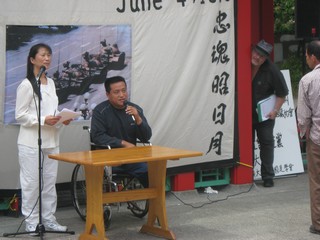
One of our speakers at the Saturday commemoration at Hing Hay Park was Fang Zheng, who lost both his legs as he pushed a young woman out of the way of an advancing tank at Tiananmen, only to be run over himself. China denied him the right to participate in the Paralympics because they didn’t want to explain how he lost his legs.
Here’s an interview from Al Jazeera, translated into English:
The Seattle Times gave our rally some coverage, focusing on Fang Zheng. Also speaking Sunday were Jane for the the Federation for a Democratic China, Don Crevie for Amnesty International, a representative from student’s group from Hong Kong and speakers from both the Democratic and Republican parties.
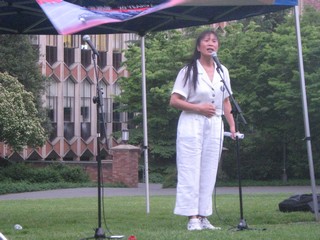
It was hot, and a little windy for the Sunday rally. Nothing like the wind that changed plans for the evening of the anniversary vigil on Thursday, June 4 starting on the HUB lawn at UW. The students from Hong Kong set up and mc’d the vigil, and Jane spoke first, giving us a moving account (in Chinese and English) of the events of Tiananmen Square, which she had taken part in 20 years ago. One of the things she talked about was how they sent in soldiers from the countryside, telling him the students were the enemy, whom the students repeatedly tried to reach out to and lecture on what was really happening (which was mentioned by a former soldier, turned artist, in a New York Times article as well).
While the day was a hot, it cooled down and clouded over by the time of the rally. Then the winds hit, starting toward the end of Jane’s speech. In addition to blowing out all our candles, the screen they were going to show scenes from PBS’ The Tank Man was blowing way too much, and the canopy was blowing away as well.
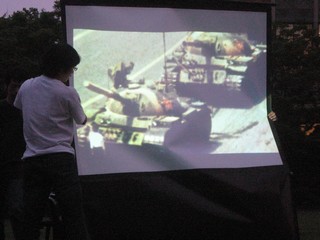
We ended up moving the rally inside the HUB, where Don carried on with AI’s concerns about China.
The students had wanted to show the section of Tank Man where they talk to current Chinese students, none of whom know of what happened at Tiananmen because the government wants it covered up.
Certainly one of the most indelible images of the Tiananmen crackdown, the photos of the young man in a white shirt standing in front of a column of tanks never ceases to fascinate me, or many others, who have tried to find out his identity and what happened to him.This week the Lens, a New York Times photojournal blog, included a feature of him and the four most common photos of his stand off. A fifth photo showed up in response to the blog, showing the young man just standing and waiting for the tanks to arrive from the distance, as nearly everyone else flees.
The video footage is equally amazing. Here is this young man, carrying his shopping bags, forcing a tank to stop. The driver of the tank tries to move around him, and he keeps moving with it, and finally climbs up on the tank, opens the hatch and says something to the soldiers inside (perhaps lecturing them, as so many students had in the days leading up to the crack down). He then gets off the tank and (while it isn’t in this video), is led off by a couple of bystanders.
Incredible! Everyone who describes watching the scene unwind at the time was sure he would be run over or shot. How incredibly brave, or foolish, depending on how you want to look at it. Did he disappear and maybe make his way out of China or just fade back into his regular life, or did the authorities get him?
Amnesty International also reports that in advance of the Tiananmen Square anniversary, some activists were taken away, others placed under house arrest, and internet sites including Twitter, Flickr and Hotmail were shut down.
So, yes, both Bhopal and the Tiananmen Square crackdown are still issues. Accountability and justice still needed, even after all these years.